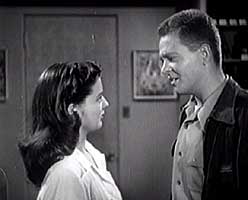 The RKO musical comedy short Let's Make Rhythm (1947) was a two-reel twenty-minute short, sometimes mistakenly listed as a soundie after it was included with compilations of soundies absent title & credits. The RKO musical comedy short Let's Make Rhythm (1947) was a two-reel twenty-minute short, sometimes mistakenly listed as a soundie after it was included with compilations of soundies absent title & credits.
Excerpted clips are included with the swing video compilation Swingtime Collection: Meet the Bandleaders Volume IV (1985) without identification, & the whole film is included on Swing Era: Stan Kenton (2004).
The scene jump-cuts to the Stan Kenton orchestra in a completely different setting with a small audience seated near Stan's piano. He plays a classical rift that turns into a dramatic jazz conclusion, only a few seconds long.
The scene then jump-cuts tothe "control room" door of a company called Music Preferred, Inc., with the slogan "Your Choice By Voice." We're about to glimpse a long-lost method of delivering music to cafes in days before the automatic jukebox, when for a coin one would talk directly into receiver to tell a music operator which record you want to hear.
The operator might be blocks or miles away, able to take requests from any number of locations. The same pre-automatic jukebox headquarters is the setting also for the Martha Tilton vehicle Swing Hostess (1944).
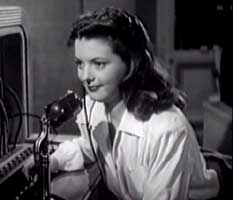 In this setting, a romantic comedy unfolds. One guy calling the music headquarters asks for "Artistry in Rhythm by Stan Kenton & his band please." In this setting, a romantic comedy unfolds. One guy calling the music headquarters asks for "Artistry in Rhythm by Stan Kenton & his band please."
A woman on the other end of the connection is one of two workers on duty, one taking the requests, the other hurrying along a bank of 78 rpm records. The second record gal puts "Artistry in Rhythm" on a turntable, while the woman taking the calls, Maya (Gail Davis), takes the next caller.
Maya turns down the offer of a date with another caller who wants to hear "A Kiss in the Moonlight." She requests he deposit a dime while the other woman retrieves the request.
The two gals converse between calls & then Maya gets a phone call from her sailor semi-boyfriend Jimmy (Jay Norris) who has been away at sea for a long time, & she's very excited to hear from him. When he's in port he'll order up many songs each night, just for the chance to talk to her, but they've never actually met in person!
"You don't even know what I look like," he tells her. She insists, "I know exactly what you look like, from the sound of your voice." She proceeds to describe the ideal leading man for a movie -- combination Cary Grant & Bob Mitchum -- though she's talking to a Mickey Rooney type of guy. But she got the sailor suit part right.
He's mustering out of the Navy that very day & wants at last to get together with his phone line sweetheart so she can see what he really looks like. She says she'd love to but it's against company policy, & so around & around the conversation goes until he very nearly proposes to her sight unseen.
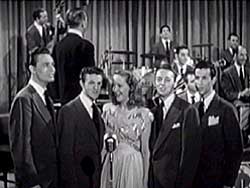 Not long after, Stan Kenton drops in at the musical control room, bringing with him June Christy & the Pastels. He's a friend of Maya's & he converses with her briefly about his performance earlier than night at the Palace Theater. He then passes through the control room into the recording studio accessible through the back door. Not long after, Stan Kenton drops in at the musical control room, bringing with him June Christy & the Pastels. He's a friend of Maya's & he converses with her briefly about his performance earlier than night at the Palace Theater. He then passes through the control room into the recording studio accessible through the back door.
With the Kenton orchestra's recording session in the background, Maya's never-met boyfriend shows up with a friend, & they're disguised as laborers. They claim they've come to service the sound equipment, though all they have with them are carpenter tools.
As this scene unfolds, we also see The Pastels -- four guys &a gal -- take up the vocal for the Johnny Richards composition "Down in Chi-Hua-Hua," with some of the crappiest lyrics ever:
"Down in Chihuahua there ain't nothin' much to do. Chi-Hua-Hua!" As a recording this was the flipside of a novelty number "His Feet Too Big for His Bed" which charted at number twelve in 1947.
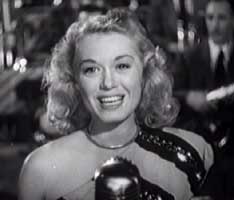 But Stan Kenton's band hangs good instrumentation on this mediocre song, with an amazing slap bass solo by Eddie Safranski. After the number wraps up, Stan prepares to begin "Just a Sittin' & a Rockin'", which we'll hear after another bit of the plot with Maya taking record requests. But Stan Kenton's band hangs good instrumentation on this mediocre song, with an amazing slap bass solo by Eddie Safranski. After the number wraps up, Stan prepares to begin "Just a Sittin' & a Rockin'", which we'll hear after another bit of the plot with Maya taking record requests.
The two guys posing as technicians screw up the system so that everything stops working. All around town, "out of order" signs are put up on the phone-request jukeboxes.
In the recording studio next door, however, things are fine, as June Christy sings "Just a Sittin' & a Rockin'." She sings it well, with breathy moments, but somehow she makes it a mite too generic. Again, though, the brass & reeds of Stan Kenton's band are pretty exciting.
Maya is upset that the jukeboxes are out of order. She thinks it means her never-met boyfriend Jimmy won't call again, not knowing he's on his knees messing around with the equipment right there in the room with her.
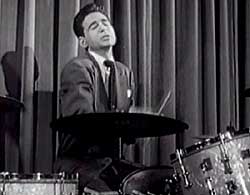 Even though the records won't play, the sound system is otherwise open, & Maya hits on the idea of having Stan Kenton's band perform live through the city's jukeboxes! Even though the records won't play, the sound system is otherwise open, & Maya hits on the idea of having Stan Kenton's band perform live through the city's jukeboxes!
As soon as a microphone is readied, Kenton at piano begins his "Concerto to End All Concertos." The trumbones then the saxes pick up the slow dance instrumental. It turns to exotica jazz when Eddie on slap-bass gets his solo & the trumpets join in, then the pace picks up so that if anyone had been dancing to the first part they'd have to stop now.
There's a drum solo by Shelly Manne, then a big close. Interesting piece, but would completely bamboozle the audience of any dance club.
While that number was playing, Maya's boyfriend has actually managed to repair what his friend mucked up, as it turns out he's an honest to gosh electrician. Jimmy apologizes for the mess he & his pal caused, Maya recognizes his voice, they kiss & are assumed to live happily ever after.
For close, the Stan Kenton orchestra begins a performance of "Tampico" with June Christy singing lead vocals, & the five members of the Pastels harmonizing, a more serious version than on the Stan Kenton soundie Tampico (1945), reviewed further down the page.
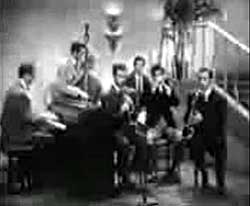 Stan Kenton & His Orchestra star in the three-minute soundie Jammin' in the Panoram (1942), self-consciously named for the Mills Panoram jukebox which played just such films for a dime.
Stan Kenton & His Orchestra star in the three-minute soundie Jammin' in the Panoram (1942), self-consciously named for the Mills Panoram jukebox which played just such films for a dime.
With an attempt to really make it look like a mini-movie, Jammin' begins with a book entitled Dance Band Hall of Fame. A hand turns the pages one by one, introducing us to cameo portraits of the band members.
We then see the small orchestra presumedly on the road performing in a number of venues, with jump cuts to their past times on the road.
Finally the editing settles down to focus on a 1942 session with vocalist Helen Huntley with the musical admonishment: "Listen all you hep-cats from the farthest corners of the nation/ It's a new day in the history of syncopation."
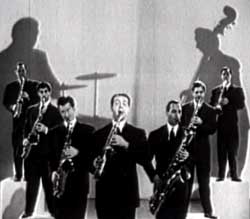 That's the entire lyric; we get no such history of syncopation. Instead the film jumps into a series of quick solos & it's over. That's the entire lyric; we get no such history of syncopation. Instead the film jumps into a series of quick solos & it's over.
Reed Rapture (1942) is another under-three-minutes soundie. It opens with Stan Kenton & His Orchestra interestingly arrayed, a row of saxophones standing against a white background, additional musicians silhouetted on the wall.
Stan is conducting from his piano bench & playing the piano here & there. The number had begun almost with a film noir mood but then gets oddly stocatto, then smooth, then again stocatto, rather an experimental number overall, most artfully staged.
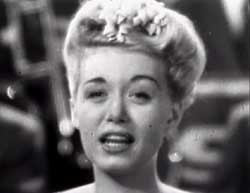 For It's Been a Long Long Time (1945), vocalist June Christy, sometimes called "Misty Miss Christy," stands in evening gown by the piano, facing Stan at the keys. They're in front of the orchestra. June begins singing very plainly & well: For It's Been a Long Long Time (1945), vocalist June Christy, sometimes called "Misty Miss Christy," stands in evening gown by the piano, facing Stan at the keys. They're in front of the orchestra. June begins singing very plainly & well:
"Just kiss me once & kiss me twice & kiss me once again/ It's been a long long time/ Haven't felt a kiss like this my dear/ Since I don't know when/ It's been a long long time."
The song was briefly a big hit, timed perfectly to sentimentalize the end of the war & the reunion of couples long separated, though not so specific to the war that it need ever fade in meaningful potential.
The Jule Styne/Sammy Kahn compositon would become an instant standard. A version by Harry James' orchestra with vocalist Kitty Kallen reached number one in the charts, & was followed immediately by another Harry James recording with Bing Crosby singing.
Versions by Irene Kaye & this one by June Christy were also released late 1945, & more versions would mount up in years to follow. The 78 rpm record of June Christy singing it for Stan Kenton is distinct from the soundie.
Christy gives it a classy interpretation. The song is easily rendered camp with too strong a snappy beat, but she sings it very naturally & sweetly. The instrumental chorus dominated by a row of saxophones is lowkey & very romantically dancable. Then June comes back in attempting a slightly different interpretation of the same lyrics.
She's a cutie & the band is pretty good, with that group sax arrangement something a little better than average. As the song is ending, Stan stands up from the piano & waves his arms around kind of nuttily with a big shit-eatin' grin. His arm motions in several films are kind of spastic which makes his conducting rather fun to watch.
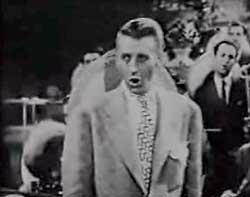 Apparently filmed the same day as It's Been a Long Long Time, June Christy once again steps out front for the vocal to Tampico (1945) by Stan Kenton & His Orchestra. This was the biggest hit the band ever had, peculiarly enough. Apparently filmed the same day as It's Been a Long Long Time, June Christy once again steps out front for the vocal to Tampico (1945) by Stan Kenton & His Orchestra. This was the biggest hit the band ever had, peculiarly enough.
Several members of the orchestra have put on sombreros. They chant more than sing: "Ai, Tampico. Tampico/ On the gulf of Me Hee Co/ Tampico. Tampico/ Down in Me Hee Co."
Thank god June comes out to take over. It's a novelty number with lyrics like "You buy a beautiful shawl/ A souvenir for Aunt Flo/ Authentic Mexican yarn/ Made in Idaho."
In between each comic verse the band does their revolting chanty choras. June's wearing a rather pleasant raggedy gown, with Spanish comb in her hair; at least she wasn't forced to wear some ill-fitting seniorita outfit. Silly though the song is, the big brass instrumental sound holding it all together ain't bad.
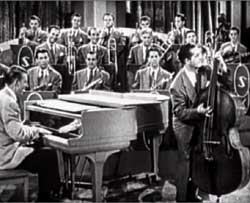 For the instrumental Southern Scandal (1946), Stan Kenton & His Orchestra are crowded together in the frame, Stan at a white piano, sharing the lead instrumental with the bass player Eddie Safranski.
For the instrumental Southern Scandal (1946), Stan Kenton & His Orchestra are crowded together in the frame, Stan at a white piano, sharing the lead instrumental with the bass player Eddie Safranski.
He & Stan do a bit of a duel between their two instruments, it being quite unusual for any orchestra but Kenton's to give so much solo time to a bass player.
It's an almost absurdly simple tune constructed around with four notes at a time. Periodically all the brass makes a loud chorus, with some solo instrumentation tucked in here & there between trumbone & sax, but always with that slap bass & the piano dominating.
It's quite an imaginative arrangement of Stan's own composition. It mucks about with the expected swing jazz conventions without entirely breaking away from the expected.
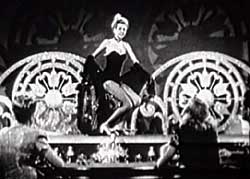 Stan again at his piano is playing much more of a jump-jazz beat than is usual with him, yet subtle with some Duke Ellington influence. It's a promising start for Eager Beaver (1945). Stan again at his piano is playing much more of a jump-jazz beat than is usual with him, yet subtle with some Duke Ellington influence. It's a promising start for Eager Beaver (1945).
His orchestra joins in with the smooth melody dominated by trumbones. Then Jean Ivory dances center stage for a skimpily clad performance right out of a burlesque house. The tacky dance is not at all in keeping with the classy melody, but sure is fun as the camera lingers on her long kicking legs & Jean pretends she really can dance.
Then we cut back to the orchestra for a big brassy sound & a sax solo, with one jump-cut to a restaurant table where a couple is smoking cigarettes & smiling happily at the floorshow.
We return to more of Jean Ivory & close-ups of her legs as she tries not to lose her blaance on her clunky high heels. Seated in the front row are a couple female clients rather than the expected shiny-pated leches.
This one plays out so close to the adult arcade roadshow panoram films it's all the more surprising they got away with the title, since it would seem Jean's beaver addressed.
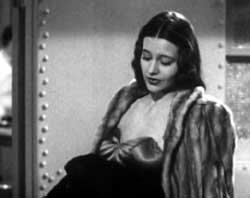 Cyd Charisse was best known as a dancer in MGM musicals, but for the soundie This Love of Mine (1942) she proves she has singing chops as well. The song was written in 1941 by Frank Sinatra, Hank Sanacola & Sol Parker.
Cyd Charisse was best known as a dancer in MGM musicals, but for the soundie This Love of Mine (1942) she proves she has singing chops as well. The song was written in 1941 by Frank Sinatra, Hank Sanacola & Sol Parker.
Set on an ocean liner, we see members of the Stan Kenton Orchestra in ship stewart uniforms playing their instruments. The band is viewed through a doorway, while out on the deck, Gary Leon leans on a rail gazing out to see, flanked by two wealthy-looking young beauties.
Gary & the blonde take off to dance together leaving the dark-haired beauty looking woebegone holding Gary's jacket. This beauty is Cyd, who out on the deck alone dances with the jacket as she sings:
"This love of mine goes on & on/ Though life is empty since you have gone/ You're always on my mind, though out of sight/ It's lonesome through the day, & all the night..."
To dance with the jacket she let her mink coat fall from her shoulders to the deck. Soon she imagines the jacket turning into Gary & they dance as she sings, quite well, a very romantic number. She conveys genuine lovesick melancholy such as gives this soundie particular strength.
Cyd's voice is a mite quavery & untrained, but with a sweet lilt. Gary seems to have liked it too, for as she finishes the number, he comes hurrying out on the deck abandoning the blonde in favor of the brunette. I suppose the blonde should be singing the next sad number.
This soundie was included in the three-soundie Official films set Romantic Rhythms (1947) together with Siegfield girl Lucile Bremer with Peter Garey in Penny Arcade (1942) & Lina Romay's Don't Get Around Much Anymore (1943).
Stan Kenton's orchestra also backed up a second vocalist for another version of This Love of Mine (1944), with Denny Areate singing & Lucile Bremer dancing.
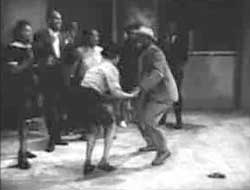 Stan Kenton & His Orchestra are unseen in The Outline of Jitterbug History (1942), but that's who is on the soundtrack.
Stan Kenton & His Orchestra are unseen in The Outline of Jitterbug History (1942), but that's who is on the soundtrack.
It opens with a comic professor (Tom Herbert) at a blackboard pointing to chalkboard addressing the prehistory of jitterbug. The camera pans in on the blackboard until a cave-woman appears in a cave, wearing a skimpy cave-woman costume, to a growly brass tune from Kenton's orchestra.
A wooly-bearded cave man enters the cave & acts very cave-mannish. When he bonks the girl with his club, it starts her dancing furiously, & he joins in.
Back in the classroom the professor points to the next part of the outline on the blackboard, "Minuet Jive." Cut to a couple in Elizabethan costume doing the jitterbug.
Then the professor points to "Square Dance Shiver" & we go next to a ho-down where two couples are square-dancing in hick costumes. A fifth gal is over at the punch bowl drinking one spiked glass of punch after another. When she's good & snockered she intrudes on the square dances & gets them all doing a shimmy-shiver dance.
The outline on the chalkboard now addresses "cutting the rug in 1912" so that momentarily we see a couple in their living room dancing.
Up until this point the dancing has been amusing but not brilliant. The last part of the outline however reads "And now -- Jitterbugging as you have never seen it!" & we're about to see Whitey's Lindy Hoppers in action!
The last minute of three is dedicated to the Lindy Hoppers who close the "historical" outline jitterbugging with great athelticism on a set made out to look like a Harlem street.
They somersault over their partners' backs (guys over gals & gals over guys), leap into the air, toss the girls feet first over the guys' heads, leapfrog, & jitterbug like crazy.
Whitey's Lindy Hoppers from the Savoy in Harlem are the truest part of history in this comedy soundie. They were the best jitterbug troupe that ever was. And they definitely save this soundie from being merely goofy.
copyright © by Paghat the Ratgirl
|
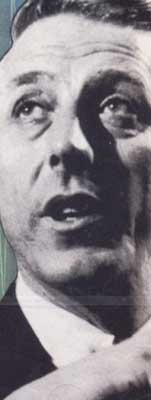

 In this setting, a romantic comedy unfolds. One guy calling the music headquarters asks for "Artistry in Rhythm by Stan Kenton & his band please."
In this setting, a romantic comedy unfolds. One guy calling the music headquarters asks for "Artistry in Rhythm by Stan Kenton & his band please." Not long after, Stan Kenton drops in at the musical control room, bringing with him June Christy & the Pastels. He's a friend of Maya's & he converses with her briefly about his performance earlier than night at the Palace Theater. He then passes through the control room into the recording studio accessible through the back door.
Not long after, Stan Kenton drops in at the musical control room, bringing with him June Christy & the Pastels. He's a friend of Maya's & he converses with her briefly about his performance earlier than night at the Palace Theater. He then passes through the control room into the recording studio accessible through the back door. But Stan Kenton's band hangs good instrumentation on this mediocre song, with an amazing slap bass solo by Eddie Safranski. After the number wraps up, Stan prepares to begin "Just a Sittin' & a Rockin'", which we'll hear after another bit of the plot with Maya taking record requests.
But Stan Kenton's band hangs good instrumentation on this mediocre song, with an amazing slap bass solo by Eddie Safranski. After the number wraps up, Stan prepares to begin "Just a Sittin' & a Rockin'", which we'll hear after another bit of the plot with Maya taking record requests. Even though the records won't play, the sound system is otherwise open, & Maya hits on the idea of having Stan Kenton's band perform live through the city's jukeboxes!
Even though the records won't play, the sound system is otherwise open, & Maya hits on the idea of having Stan Kenton's band perform live through the city's jukeboxes!
 That's the entire lyric; we get no such history of syncopation. Instead the film jumps into a series of quick solos & it's over.
That's the entire lyric; we get no such history of syncopation. Instead the film jumps into a series of quick solos & it's over.




